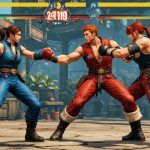Understanding Character Equality in Fighting Games
Character equality is crucial in maintaining fairness and competitive integrity within fighting games. At its core, character balance ensures no particular character has an overwhelming advantage, thus fostering an engaging and varied player experience. Successful equality is evidenced in games where diverse characters with different playstyles maintain a level playing field.
Historically, balancing characters has been fraught with both failures and successes. Some games have struggled with characters deemed too powerful, leading to player frustration and loss of interest. However, in successful iterations, developers have fine-tuned fighting game mechanics to cater for competitive fairness and enjoyment.
The impact of character equality on player experience cannot be overstated. Players are more likely to remain engaged when they feel victories result from skill rather than imbalance. Moreover, balanced characters can significantly enhance the game’s longevity, encouraging continued investment both emotionally and financially.
When a fighting game respects these equality principles, it promotes not only the skill of its players but also the integrity of its competitive scenes, leading to a thriving community and lasting appeal. The commitment to continuous improvement in character balance is paramount to a game’s success.
Also to discover : Accelerate Authenticity: The Impact of Real-Time Ray Tracing on Reflections in Racing Games
Core Principles of Character Design
Character design in fighting games involves a delicate interplay of gameplay dynamics and creative innovation. At the forefront, developers must incorporate balance strategies that ensure no single character dominates due to their abilities. This is achieved by embedding fundamental design principles that cater to both unique traits and competitive fair play.
Fundamental Design Principles for Fighting Game Characters
Effective character design revolves around distinct and memorable abilities and strengths. A diverse set of traits not only adds flavour to the game but engages players with varied strategies to master. These unique abilities must be balanced with overarching game mechanics to prevent power imbalances.
Role of Unique Abilities and Strengths
While unique abilities define a character, integrating them into the broader game environment requires precision. Characters should possess signature moves that offer advantages without overshadowing others. Strategies must include balancing these powers, allowing all players to find their niche within the combat system.
Importance of Weaknesses and Counters
Counterbalancing strengths with inherent weaknesses promotes fair play. Characters should exhibit vulnerabilities that other fighters can exploit, fostering a dynamic and competitive environment. Players benefit from strategizing around these counters, ensuring victories reflect skill rather than an insurmountable advantage.
Game Mechanics Analysis
Exploring game mechanics in fighting games reveals how integral these are to a character’s viability. Core game mechanics determine the effectiveness of combat systems and can make or break character balance. Developers employ diverse strategies to ensure mechanics align with combat systems, enhancing gameplay without bias.
In popular games, a well-designed mechanic ensures all characters are equally viable, avoiding unfair advantages. Effective combat systems transform unique abilities into opportunities for strategic play. Achieving this harmony requires detailed analysis and precise adjustments to gameplay elements.
Testing Techniques
To maintain balance, developers utilize various testing techniques. Such methods include simulating battles under multiple scenarios, assisting in refining character capabilities. These trials help adjust game mechanics fairly, ensuring no character dominates by mere mechanics.
Testers meticulously evaluate how mechanics influence each character’s performance. The goal is to discern the effectiveness of movesets, specials, and environmental interactions, leading to informed adjustments. Testing techniques are crucial; they underpin the iterative process of achieving robust balance.
Ultimately, the ability to test game aspects ensures mechanics promote a level playing field, fostering a complex yet fair competitive environment. The resulting balance is pivotal, ensuring that a character’s success relies on skill rather than mechanical supremacy.
Successful Examples from the Industry
In examining successful character balance in fighting games, certain standout titles provide valuable insights. One case study often highlighted is “Street Fighter V.” Through rigorous fine-tuning and community feedback, its developers have managed to create an environment where varied characters coexist on an even playing field.
Key to achieving this balance has been the game’s commitment to maintaining and updating its fighting game mechanics and equality principles. Regular updates ensure that new characters or mechanics do not disrupt the existing balance, a common pitfall for many titles in the genre.
In interviews, developers often cite their iterative process as vital. This includes listening to both competitive and casual players, an approach which underscores the importance of diverse perspectives in character balance assessment. By drawing lessons from past iterations, these studios refine their approach, optimizing fairness and enjoyment for players across all skill levels.
Successful balancing is not simply a static goal but a dynamic process. Through continuous adjustments and dialogue with their player communities, these industry examples maintain a balance that enhances game longevity and retains player interest. This illustrates the significant impact of effective character balance on a game’s success.
Practical Tips for Playtesting
Playtesting is pivotal in achieving balanced character design and enhancing gameplay dynamics. Effective playtesting strategies encompass structuring sessions to refine balance strategies by evaluating player experiences.
Structuring Effective Playtesting Sessions
Creating structured playtesting sessions requires purposeful planning. Testing should represent a variety of perspectives. This involves organizing a diverse player pool that reflects a range of skill levels and playstyles, thus ensuring comprehensive feedback on character equality. By simulating different gameplay scenarios, developers can better understand the effectiveness of fighting game mechanics.
Gathering and Analyzing Player Feedback
Compiling player feedback is foundational for assessing character balance. It involves utilizing surveys, interviews, and in-game data to capture insights on gameplay dynamics and character design. Analyzing this data highlights potential imbalances in abilities or strengths, guiding informed revisions that maintain fairness.
Iterating Based on Testing Results
Once feedback is collected, iteration is key to balance strategies. Developers need to synthesize player experiences with quantitative data, facilitating adjustments to combat systems where players identify issues. This ongoing refinement is crucial as it enhances game mechanics, promoting equitable and engaging character interactions. Sustained testing instills confidence in character balance, influencing game longevity and player satisfaction.
Tools for Assessing Balance
In the realm of fighting games, employing balance analysis tools is crucial for achieving optimal character design. These tools provide a data-driven approach, enabling developers to meticulously fine-tune character abilities and maintain equality principles.
Data analytics play a pivotal role in assessing character equality, offering insights into how characters perform across diverse scenarios. By analyzing metrics such as damage output and win rates, developers can identify and address imbalances, ensuring a fair gaming environment.
A variety of tools assist in this data-driven development. For example, telemetry systems collect and process in-game actions, while machine learning algorithms predict potential balance issues by analyzing player patterns. By integrating these technologies, developers enhance their ability to adjust character strengths and weaknesses effectively.
Looking to the future, advancements in balance assessment technology promise even greater precision and efficiency. Innovations such as real-time analytics will allow for instant feedback and rapid adjustments, further ensuring that character balance evolves alongside gameplay dynamics.
- Key Benefits:
- Enables precise adjustments based on concrete data.
- Enhances long-term player satisfaction by maintaining fair play.
- Supports continuous improvement of game mechanics through iterative analysis.
Utilizing balance analysis tools ensures fighting games deliver a consistently engaging experience.
Tools for Assessing Balance
Utilizing balance analysis tools in fighting games is indispensable for achieving optimal character design. These tools empower developers to finely adjust character abilities, ensuring adherence to equality principles.
Data analytics forms the backbone of this process, enabling precise character equality assessments by evaluating performance metrics, such as damage output and win rates. This data-driven approach helps identify potential imbalances, maintaining a fair competitive environment.
Several tools are pivotal in this data-driven development:
- Telemetry systems: Track and analyze in-game actions.
- Machine learning algorithms: Predict balance issues by examining player behaviour patterns.
Integrating these technologies facilitates effective adjustments to character strengths and weaknesses. As balance assessment technology continues to evolve, advancements like real-time analytics will provide instant feedback for rapid modifications, ensuring character balance evolves alongside gameplay dynamics.
Key Benefits
- Enables accurate adjustments grounded in concrete data.
- Enhances long-term player satisfaction by upholding fair play.
- Supports continuous refinement of game mechanics through iterative analysis.
In conclusion, implementing balance analysis tools is critical in ensuring fighting games deliver a consistently engaging and fair experience for players.











